If the mouse right-click is not working in Excel, you can use the solutions provided in this article. The right-click context menu is used for various functions, including copying and pasting data, locking and unlocking the cells or sheets, inserting and formatting cells, creating hyperlinks, etc. When the mouse right-click stops working in Excel, it creates problems for users because it affects their productivity.
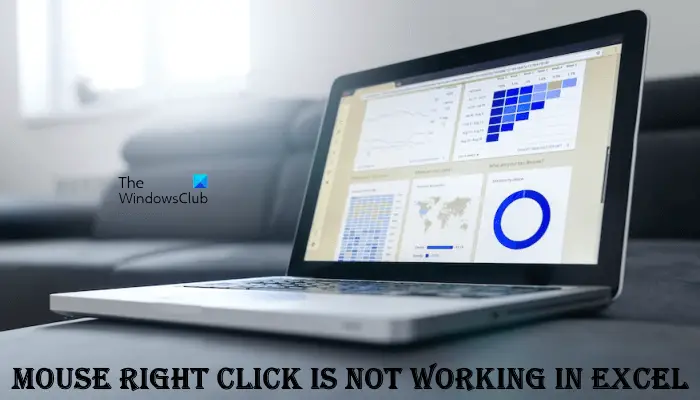
Why can’t I right-click in Excel?
If the right-click is not working in Excel, there might be some add-in(s) responsible for the problem. You can check this by opening Excel in Safe Mode. In addition to this, the XLB file of Excel might have been corrupted. The XLB file contains Excel settings and configurations. Corruption in this file causes problems.
Mouse right click is not working in Excel
Usually, when the mouse right-click does not work on Windows, you can try fixes, like updating or reinstalling the mouse drivers, Checking add-ins, running the hardware and Devices Troubleshooter, restarting Windows Explorer, repairing system image files, etc. But here, it is an Excel-specific issue. Hence, you have to use some additional fixes to resolve the problem. The following solutions will surely help you if your mouse right-click is not working in Excel.
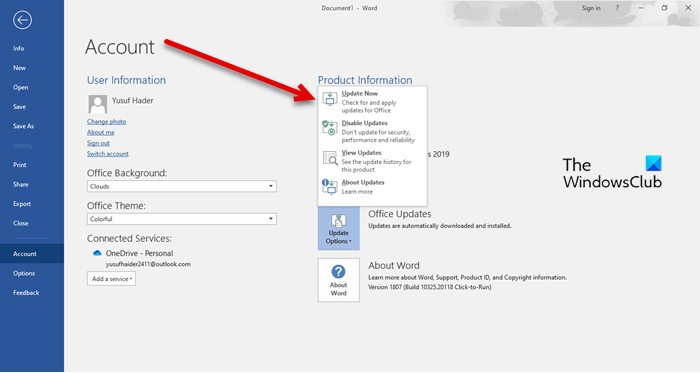
First, close Excel and restart your computer. Now, open Microsoft Excel and see if the problem persists. In some cases, restarting the computer fixes most issues. We also suggest you check for Office updates manually. Install the updates (if available). If this does not work, proceed ahead and use the following fixes.
- Move the XLB file to another location
- Open Excel in Safe Mode
- Run a VBA script in Excel
- Troubleshoot in a Clean Boot state
- Delete the Options folder from the Registry
- Repair Office
Let’s see all these fixes in detail.
1] Move the XLB file to another location
XLB is an Excel file that stores Excel settings and other configuration information. This file is located on your C drive, provided Microsoft Office is installed on that drive. If the configuration of Excel gets corrupted, you may experience several issues in Excel like one. A solution to such types of Excel problems is to delete the XLB file.
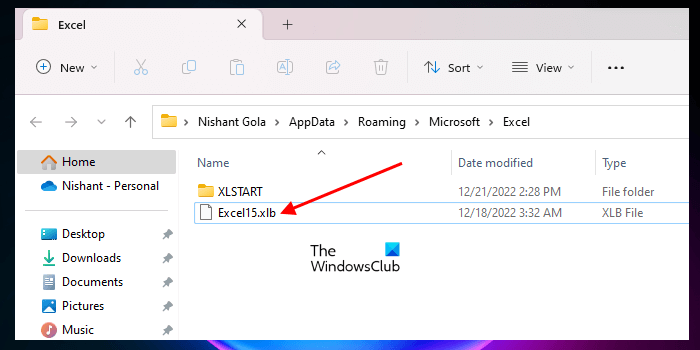
Deleting the XLB file is completely safe. Also, you will not lose your data and other information in Excel after performing this action. When you delete this file, Excel will recreate it when you open Excel. However, we recommend you move this file to another location instead of deleting it so that you can recover it again if any problem occurs.
Go to the path mentioned below:
C:\Users\Username\AppData\Roaming\Microsoft\Excel
In the above path, replace the Username with your user name. After reaching the above path, you will see the XLB file there. The easiest way to go to the above path is via the Run command. Open the Run command box by pressing the Win + R keys and type the following command. After that, hit Enter.
%appdata%\Microsoft\Excel
The above command will directly take you to the location where the XLB file is located. Now, move the XLB file from there to another location by using the Cut and Paste method.
2] Open Excel in Safe Mode
Moving the XLB file to another location fixes the issue in most cases. But if the above fix does not work, the cause of the problem might be an installed add-in. Microsoft Office applications provide users with the facility to install additional add-ins to make their work easier. Sometimes, these add-ins cause problems with Office applications. This might be the case with you. To check this, close Excel and launch it in Safe Mode.
If the problem disappears in Safe Mode, this means that the issue is occurring due to an add-in. In this case, you have to identify the problematic add-in. To do so, exit Excel Safe Mode and open it in normal mode. Now, start disabling the add-ins one by one and check the status of the issue after you disable each add-in. This process will take time but you will be able to identify the problematic add-in in Excel. Once you find the problematic add-in, remove it and find its alternative.
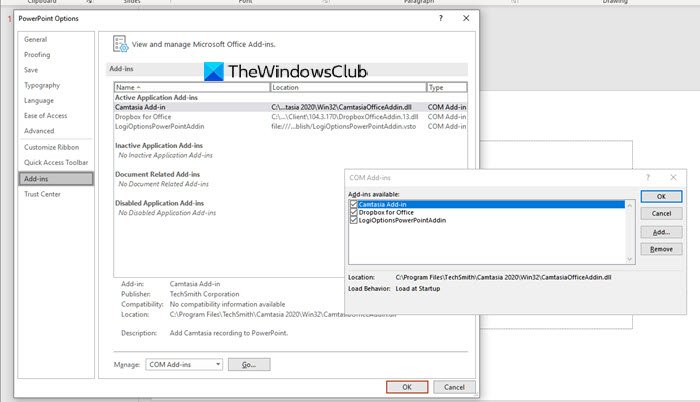
The following steps will guide you on how to disable add-in in Excel.
- Open Excel.
- Create a blank document or open an existing one.
- Go to “File > Options.”
- Select Add-Ins from the left side.
- Select COM Add-ins in the Manage drop-down on the right side.
- Click Go.
- Uncheck the add-in that you want to disable and click OK.
3] Run a VBA script in Excel
If the right-click is still not working in Excel, run a VBA script in Excel. This method has fixed the issue of many users. Hence, you should also try this. To do so, the Developer tab must be enabled in Excel. If you do not see the Developer tab on the ribbon, enable it first.
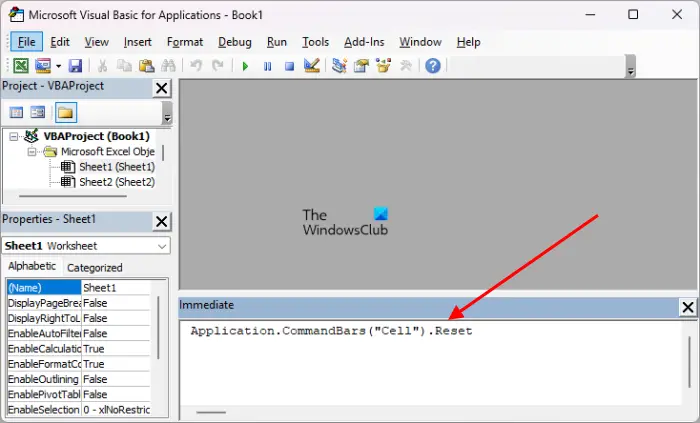
Now, go to the Developer tab and select Visual Basic. This will open the Visual Basic editor in Excel. In the Visual Basic window, click under the Immediate section available at the bottom. If you do not see it, press the Ctrl + G keys. Type the following script and hit Enter.
Close the Visual Basic Editor window and your problem should get fixed.
4] Troubleshoot in a Clean Boot state
When we start our computer, lots of services also start automatically and keep running in the background. These Services include Microsoft and other third-party services. Microsoft Services are crucial for the proper functioning of a Windows computer. Hence, disabling these services can make your system unstable.
Sometimes, third-party background apps and services conflict with other applications and prevent them from working properly. This might be the case with you. To check this, start your computer in a Clean Boot state. Clean Boot is a troubleshooting state where all the third-party services and startup apps remain disabled.
Launch Excel in the Clean Boot state and see if the problem persists. If not, a third-party service or background app is responsible for the issue.
Troubleshoot in the Clean Boot state to identify the culprit. To do so, enable all the background apps and restart your computer. After restarting your device, launch Excel and see if right-click works. If yes, one of the background apps is the culprit. Now, disable the startup apps one by one via the Task Manager and restart your computer after disabling each background app. After restarting the computer, open Excel and check the status of the issue.
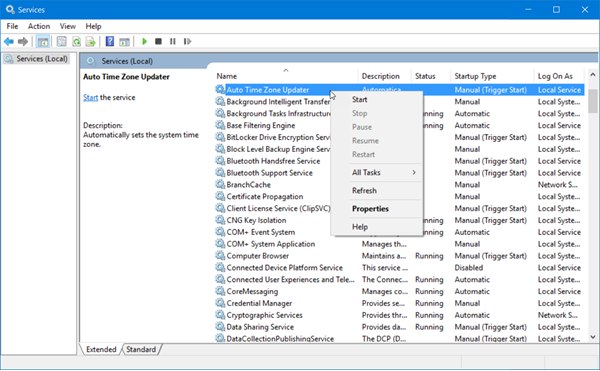
Follow the same steps to identify the problematic third-party service. But this time, you have to use the MSConfig app instead of the Task Manager. Once, you find the problematic third-party service, disable it permanently by using the Services Manager.
Related: Can’t type numbers or enter data into Excel cell.
5] Delete the Options folder from the Registry
This solution requires modifications in Windows Registry. Windows Registry is a hierarchical database of the Windows operating system. Therefore, you should be careful while modifying it as any mistake can lead to serious errors. We recommend you create a System Restore Point and backup your Registry before performing the steps written below.
Press the Win + R keys to open the Run command box. When the Run command box appears, type regedit and click OK. Click Yes in the UAC prompt. This will launch the Registry Editor.
Copy the following path and paste it into the address bar of the Registry Editor. After that, press Enter.
Computer\HKEY_CURRENT_USER\Software\Microsoft\Office
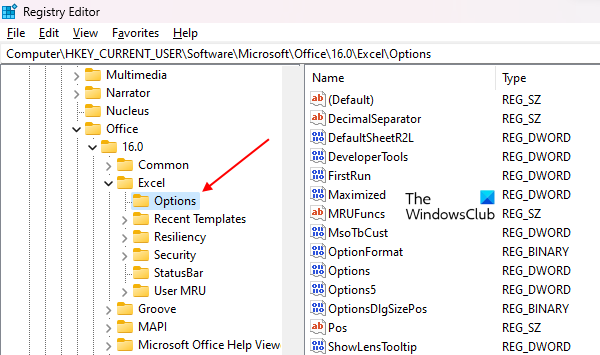
Expand the Office folder and then expand the folder that represents your Office version number. In my case, it is folder 16.0. It should contain the folders of all Office applications. Expand the Excel folder.
Now, right-click on the Options folder and select Delete. Before you delete the Options folded, make sure that it is located inside the Excel folder.
6] Repair Office
If none of the above solutions worked, repairing Office will help. First, try Quick Repair. If it does not work, run an Online Repair. Online Repair will take more time than Quick Repair but it is more effective than Quick Repair.
I hope this helps.
Read next: Cannot create List in Excel: The file does not exist.
Leave a Reply